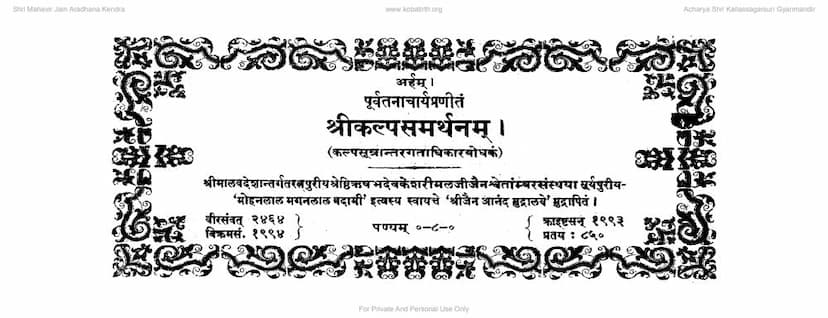Kalp Samarthanam
Added to library: September 2, 2025

Summary
Here is a comprehensive summary of the Jain text "Kalp Samarthanam," based on the provided pages.
Book Title: Kalp Samarthanam (कल्पसमर्थनम्) Author(s): Purvatanacharya (पूर्वातन आचार्य) Publisher: Rushabhdev Kesarimal Jain Shwetambar Sanstha (ऋषभदेव केसरीमल जैन श्वेतांबर संस्था) Catalog Link: https://jainqq.org/explore/020428/1
Overall Purpose and Content:
"Kalp Samarthanam" is a significant Jain text that delves into various aspects of Jain monastic discipline, practices, and the lives of Tirthankaras. The title itself suggests a defense or justification of the "Kalpa" (a set of monastic rules and observances, primarily referring to the Paryushan Kalpa). The text appears to be a commentary or a compilation that explains and elaborates on the rules and traditions, often by referencing earlier scriptures and providing historical narratives.
Key Themes and Sections:
The text is structured into several sections, often indicated by "Sutram" (सूत्र) numbers, suggesting it's a commentary on or an elaboration of existing Jain canonical texts. Based on the provided pages, the main themes include:
- Elaboration on the Paryushan Kalpa: A significant portion of the text is dedicated to explaining the nuances and specific rules related to the Paryushan festival and its associated observances (e.g., fasting periods, types of alms).
- Distinctions in Practices: The text highlights differences in practices based on the era of Tirthankaras (Purima, Pachchima, Majjhima) and their implications for monastic life.
- Stories and Narratives (Itihasas): The book recounts numerous stories, often illustrating the importance of tapas (austerity), right conduct, and the consequences of actions. Notable narratives include:
- The story of Nagaketu: This extensive narrative emphasizes the power of devotion, austerity, and the spiritual journey, highlighting themes of rebirth, karmic consequences, and divine intervention. It showcases how past actions influence present lives and the importance of virtuous conduct.
- The story of Meghakumara: This story illustrates the suffering faced by ascetics and the importance of equanimity and perseverance through hardship, drawing a parallel between the protagonist's past lives and his present ascetic practice.
- The stories of Tirthankaras (Rishabha, Ajit, Sambhava, Abhinandan, Sumati, Padmaprabha, Suparshva, Chandraprabha, Pushpadanta, Sheetala, Shreyamsa, Vasupujya, Vimala, Ananta, Dharma, Shanti, Kunthu, Arah, Malli, Munisuvrata, Nami, Nemi, Parshva, Mahavir): The text provides brief accounts of the lives, key events, and timelines of the Tirthankaras, including their birth, initiation, enlightenment, and nirvana. It also details significant events like the birth festivals, naming ceremonies, and the establishment of their teachings.
- The story of the Ganadharas: The text elaborates on the debates and philosophical discussions between the first disciples (Ganadharas) and others, particularly highlighting the intellectual prowess and arguments of prominent figures like Indrabhuti Gautama. It showcases the process of resolving doubts and establishing Jain doctrine through reasoned discourse.
- The story of Rishabha (Adinath): The narrative of the first Tirthankara, Lord Rishabha, detailing his lineage, birth, the establishment of civilization, and his ascetic path.
- Commentary on Scriptures: The text refers to and explains terms and concepts from other Jain scriptures like the Dasha Shruta Skandha and the Paryushan Kalpa.
- Virtues and Principles: Throughout the narratives, the text emphasizes core Jain virtues like non-violence (ahimsa), truthfulness (satya), austerity (tapas), charity (dana), compassion (daya), and right faith (samyaktva).
- Discussion on Purity and Observances: It touches upon discussions related to the purity of water, food, and the implications of certain practices for ascetics. The purity of certain types of water, even when boiled or mixed, is discussed.
- Importance of Asceticism: A recurring theme is the paramount importance of asceticism (tapas) as a means to attain liberation and overcome karmic bonds.
- Sravaka (Lay Follower) Practices: While primarily focusing on monastic aspects, it also touches upon the conduct and duties of lay followers.
Author and Context:
The text is attributed to "Purvatanacharya" (ancient acharyas), suggesting it compiles or explains the teachings of earlier Jain scholars. The publication by the "Shri Jain Anand Mudralaya" indicates a traditional Jain scholarly endeavor to preserve and disseminate religious knowledge. The introductory remarks mention the text being written after the 13th century and before the 17th century Vikram Samvat, placing its composition in a significant period of Jain literary activity. The introduction also touches upon specific historical debates within the Jain tradition, particularly concerning the practice of consuming Kanji (sour gruel) and the role of different monastic lineages (gachhas).
Significance:
"Kalp Samarthanam" serves as a vital resource for understanding the intricate details of Jain monasticism, the philosophical underpinnings of Jain practices, and the historical development of Jain traditions. It is a testament to the scholarly tradition of Jainism, aiming to provide clarity and justification for established practices and teachings, often through illustrative stories and detailed explanations. The text emphasizes the rigorous path of an ascetic and the karmic consequences of actions, guiding both monastics and lay followers towards spiritual progress.